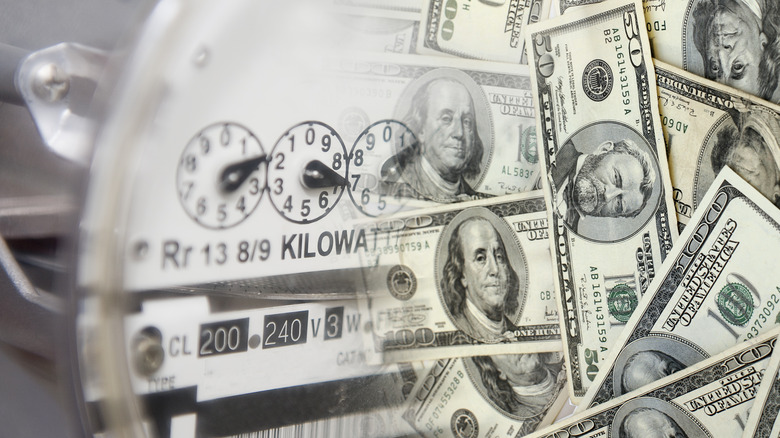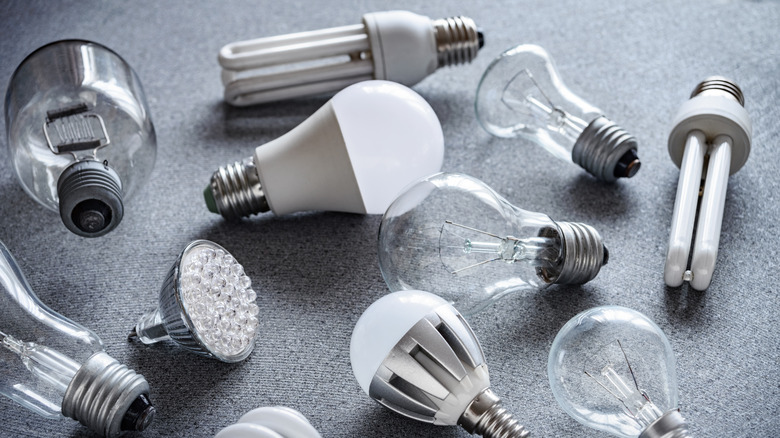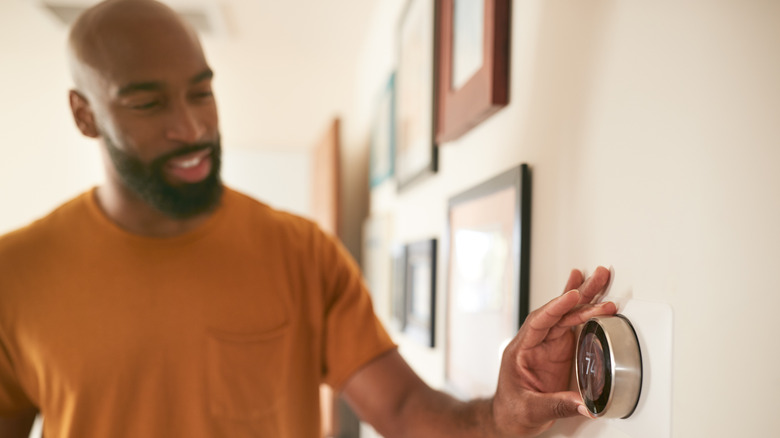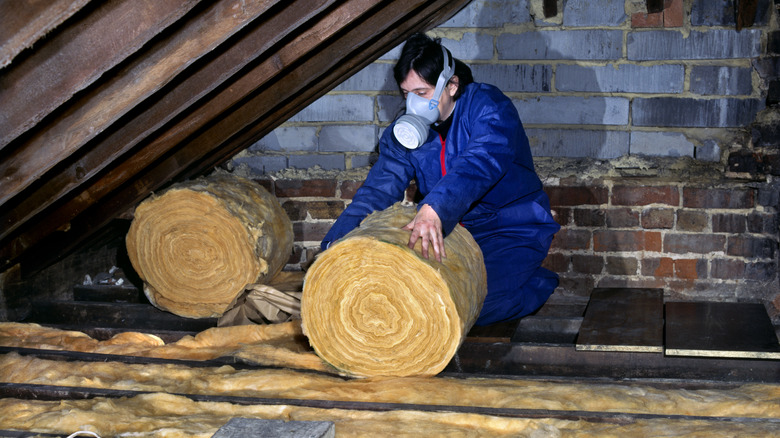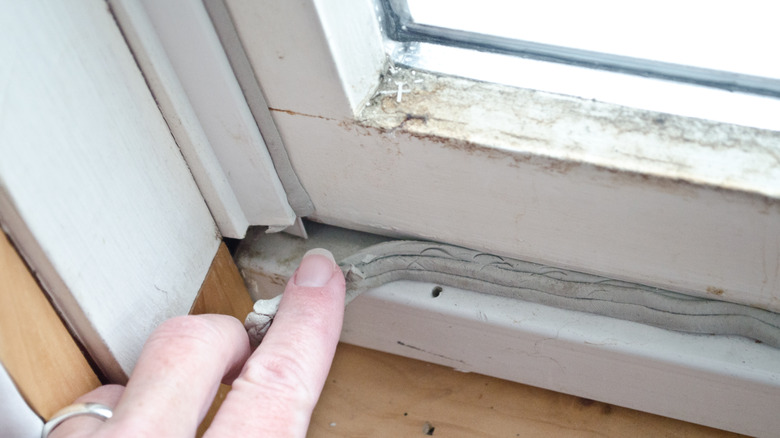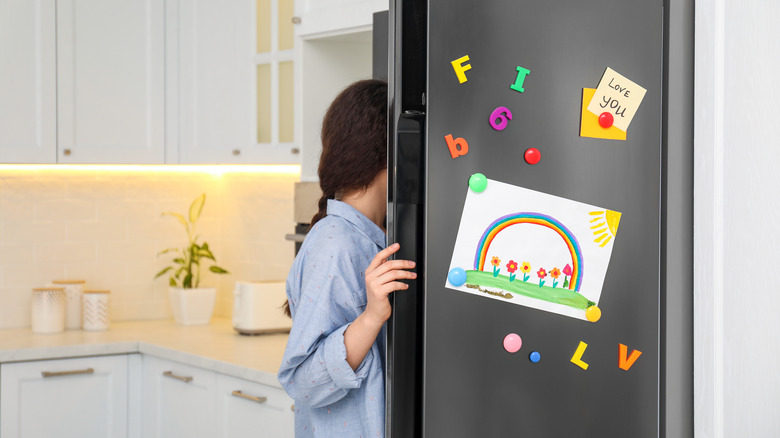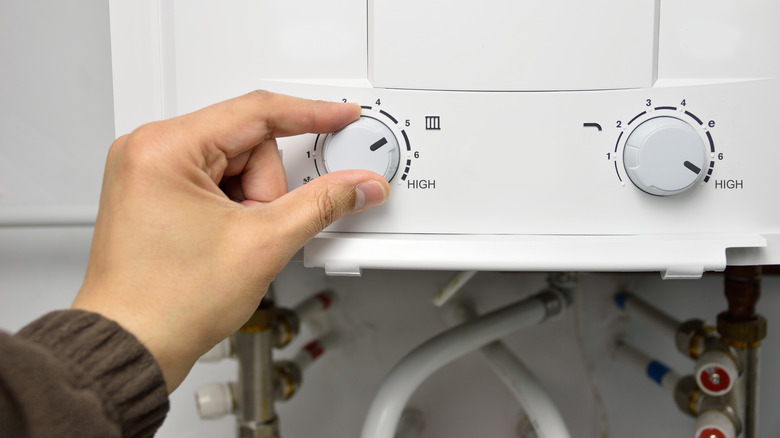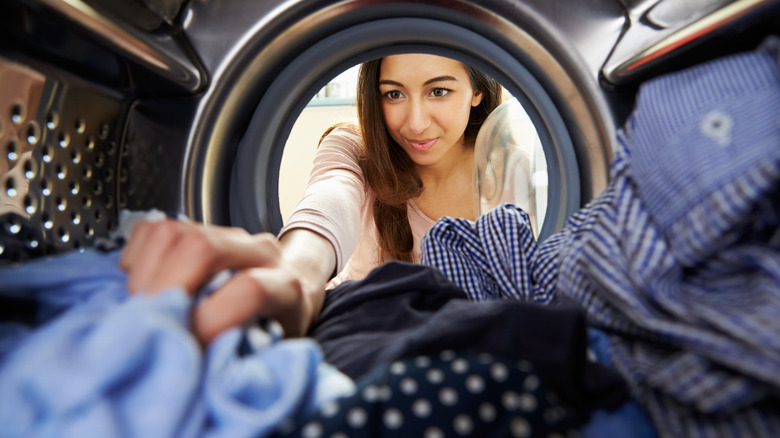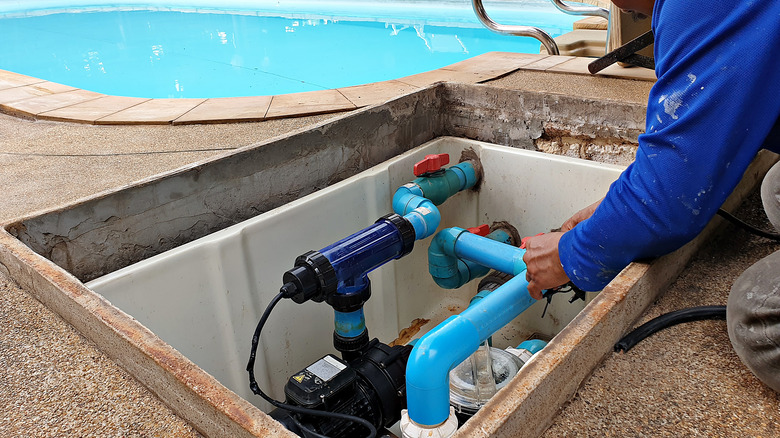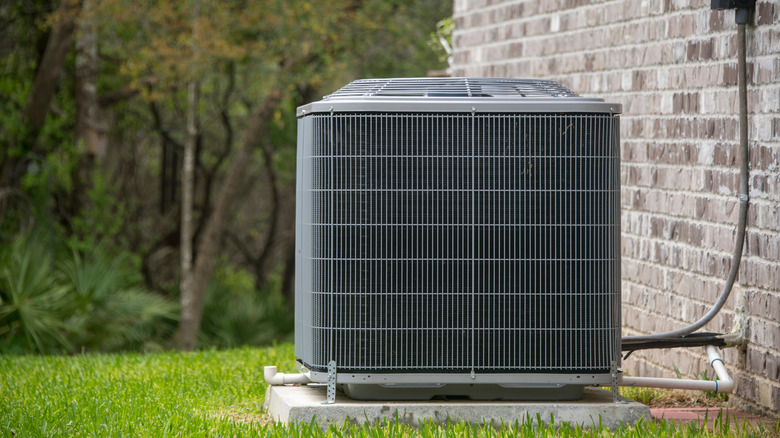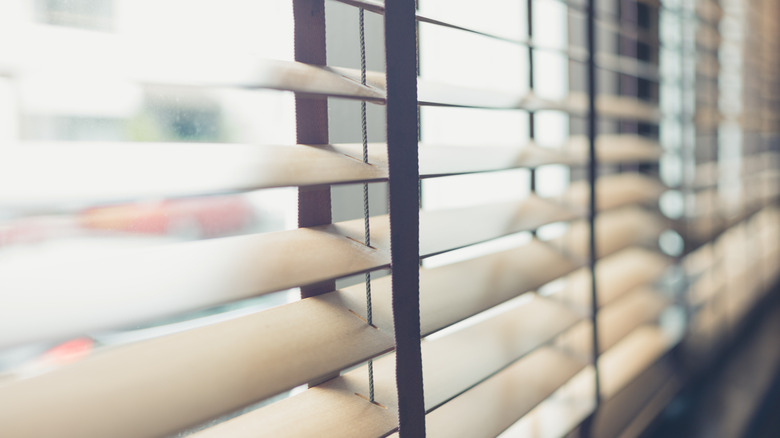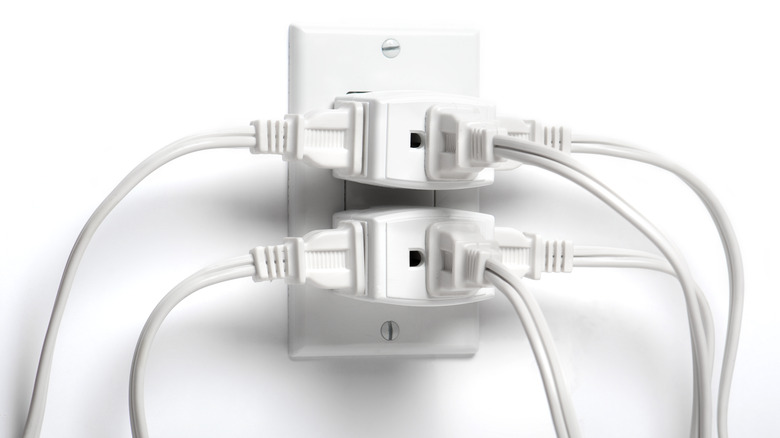The Real Reason Your Electric Bill Is Through The Roof
Nobody looks forward to getting their electric bill in the mail. Unless you've opted for 100 percent solar energy, or you're cool with only reading by candle light, there's no escaping the electric bill. There likely are, however, a host of reasons as to why your electric bill is through the roof some months and a bit less squirrely during others.
Pinning down the exact reason why your jaw hits the floor when you open up the electric bill can be a bit tricky. Maybe your visiting in-laws demanded that the house be kept at 80 degrees in January. Perhaps that old refrigerator from the Clinton administration out in the garage is using a bit too much juice. Maybe you simply need to invest in some solid blackout curtains. Oh, it could be your HVAC unit — that's a definite possibility.
These are all the reasons why your electric bill keeps going up, up, up and how to tame it before it gets even more out of control.
Using the wrong light bulbs can really add up
You might not think that light bulbs would play much of a part in your high electric bill. After all, they're so small when compared to a big, buzzing refrigerator or dryer. But just think about how many light bulbs are in your home. You probably have at least a couple in every room in the house, and according to the U.S. Department of Energy, lighting alone accounts for around 5 percent of residential energy usage.
Incandescent bulbs are always going to be the cheapest, but light bulbs have come a long way since Edison Electric Light Company began making incandescent bulbs in 1880 (via Interesting Engineering). These bulbs have their place, but they may not always be the best choice.
For example, if you were to install compact fluorescent lamps (CFL) or light-emitting diodes (LED) in the fixtures that get the most use, you could save a few dollars every month. The reason is because these bulbs give off less heat and use less energy to produce light. Choose light bulb models that have an Energy Star marking and the savings amount to around $45 a year. The takeaway here: Not all light bulbs are created equal, and choosing the cheapest bulb might cost you more at the end of the month.
You could be over-adjusting the thermostat
There's a great scene in the 2017 comedy Daddy's Home 2 where Will Ferrell, Mel Gibson, and John Lithgow are appalled at the discovery that "somebody fiddled with the thermostat." It's an act of disobedience that leaves the men in utter disbelief — and there's a good reason for that.
Messing with your thermostat and pushing it too far in one direction can really impact your electric bill. Your HVAC system works hard to maintain the temperature inside your home. So when the thermostat is adjusted from, say 67 to 72 degrees Fahrenheit, it's working especially hard to make that change. With heating accounting for a whopping 50 percent of home energy usage, it's easy to see how this can really impact a utility bill.
"When you adjust it by more than two degrees, your HVAC system works a lot harder and that caused more energy use and that causes a higher bill," Jacksonville Electric Authority spokesperson Simone Garvey-Ewan told local news station News4Jax.
The same goes for cooling your home, too. If you come inside on a hot summer day, don't crank your air conditioner down to a lower-than-normal temperature with the idea that it will cool your home faster. Alabama's Pea River Electric Cooperative says this doesn't work, and it'll only result in unnecessary energy usage. If you want to take things a step further, consider a programmable thermostat. It could potentially shave $180 off your bill over the course of a year.
Poor home insulation isn't helping your electric bill
Most people probably don't think about their home's insulation very often. Since it's usually hidden behind walls or up in the attic, insulation is one of those out of sight, out of mind things. But a home with poor insulation can easily translate to a loss of heat, thus forcing your heater to work harder to maintain the temperature. The same goes for air conditioning in the summer months, according to This Old House.
Whether it's loose fill natural fiber, spray-in foam, fiberglass rolls, or any other type of insulation, it all serves the same purpose — to keep heat from getting in or out of the home. Now for the shocking news: there's an extremely high possibility that your home is under-insulated. In fact, according to the North American Insulation Manufacturers Association, 90 percent of U.S. homes don't have enough insulation.
Here's the thing about upgrading home insulation — it's not cheap and can easily run over $1,000. That said, general contractor Tom Silva told This Old House that the long-term energy savings benefits almost always justify the cost. "It's the wisest way to invest that I know of," Silva said. So how much will an insulation upgrade cut down on your electric bill? That's obviously going to vary based on region and the size of your home, but the average savings is around $200 a year. It's easy to see how after just a few years, that new insulation has paid for itself.
Drafty windows and might as well be sucking money out the window
Nothing's worse than a drafty window in the middle of January when the snow is coming down, and the wind is whipping up some fierce cold. A drafty window will not only have you wrapping yourself in extra blankets, but it will negate all that cozy warm air your heater is filling your home with. Just like with a lack of insulation, the harder your heater has to work to keep the inside thermostat temperature in check, the pricier your electric bill is going to be.
If you can fix those drafty windows (and doors), the U.S. Department of Energy estimates it can reduce up to 20 percent of your annual electricity usage. It doesn't take much space for air to leak out of a window or door, so sealing up drafty areas can make a big difference.
Aside from replacing the entire window itself, there are much cheaper ways to seal a drafty window. The various solutions range from outfitting windows with foam weather stripping to glazing window panes, or breaking out the caulking gun to fill in cracks (via This Old House).
An old refrigerator can be an energy hog
Various refrigerator mistakes, such as over-filling your fridge, can contribute to higher energy costs, but the appliance itself can be a major energy sucker no matter what's inside. According to Consumer Reports, major household appliances account for around 9 percent of home energy costs and few appliances in your home can match the electricity usage that your fridge eats up 24/7. If that fridge in your kitchen is an older model, there's a good chance it's using more electricity than you might think.
SFGate points out that older refrigerator models often use more electricity than newer ones as their motors start to wear down and doors develop leaky seals. When the rubber seal around a refrigerator's door begins to crack and stretch, cold air leaks out. Much like with a drafty window, the refrigerator motor has to work that much harder to maintain its cold temperature.
Old refrigerators aren't just subject to leaky seals or old motors. A wonky fridge thermostat can also wreak havoc on your electricity bill. Even dirty coils can result in a higher electricity bill every month as dirt and grime makes it more difficult for the coils to pull heat from the fridge (via Family Handyman).
All that said, a new refrigerator can be an expensive purchase. If you're on the fence about spending the money for a new model, Energy Star has a Flip Your Fridge calculator to compare your old fridge's operational expense with that of a new one.
A water heater with a high temperature can equal a high electric bill
We all love a hot, steamy shower, but those hot showers and warm baths aren't free. If you have an electric water heater, then you can bet that it accounts for around 17 percent of your electricity costs (via Direct Energy). Unless you plan on only taking cold showers, there's really no way of getting around the cost of having to heat up water. This doesn't mean, however, that you can't take the appropriate measures to keep your water heater electricity usage in check.
The size and age of your water heater factor into how much electricity it uses. And while there's not much you can do about that — other than replace it — you do have control over one important variable. If your water heater's temperature setting is too high, then it's using unnecessary energy. There's a good chance that when your water heater was installed its default setting was 140°F, but Direct Energy advises that 120°F is plenty hot enough for most homes. Adjust the dial down and watch that sweet electric bill shrinkage!
Because the tanks lose heat, electric water heaters heat the tank for around five hours a day. You can reduce some of this heat loss — and save energy — with an insulation blanket. It's important to note, though, this is a special blanket just for water heaters. So don't go wrapping your water heater in grandma's afghan.
Running the dryer runs up the electric bill
Just like the refrigerator, the clothes dryer is another appliance that eats up electricity like nobody's business. Yes, they're a wonder of modern convenience, but it takes a lot of electricity to produce enough heat to dry a pair of sopping wet blue jeans.
According to Direct Energy, most electric dryers run at 2,000 to 6,000 watts or 2 to 6 kilowatt hours. Because electric companies determine your bill by how many kilowatt hours you use, and the average electric company going rate is around 12 cents per kilowatt hour, running a 2,000 watt dryer for an hour would cost around 24 cents. A 4,000 watt dryer would cost around 48 cents to run for an hour and a jumbo 6,000 watter would cost about 72 cents. If you have a big household with big baskets of dirty laundry, those 48 cents to run the dryer several times a week can add up quickly.
Aside from opting to go 100 percent the clothesline route, cleaning the lint trap after each use, drying similar fabrics together, and using the residual heat from the previous load to work for the next load, can all help stretch those cents further.
Your refreshing swimming pool could be the culprit
Who doesn't love a refreshing dip in the swimming pool? Nothing beats it on a hot day, and if you're lucky enough to have a heated pool, well, color us green with envy. Even still, at the risk of sounding like a total buzzkill and ruin the pool party, we must point out that your sparkling swimming pool is definitely adding some big bucks onto your electricity bill.
If you have a swimming pool, your electricity bill will almost certainly be higher than your pool-lacking neighbors — it could be almost 50 percent higher. While part of this has to do with the fact pool owners also tend to use more electricity in other lifestyle areas, the pool is most certainly a factor in a high electricity bill. That's because the pump that circulates all that water through the pool filter uses a lot of power — around 2,500 kilowatt hours a year (via Think Progress). Heating that pool won't come cheap, either.
Diving into a cold pool isn't appealing to everyone and according to the Department of Energy, heating a pool can cost hundreds of dollars a year, depending on where you live and whether or not you use a pool cover. For example, to heat a covered 1,000 square foot pool in Atlanta from the beginning of April to the end of October at a modest 78 degrees Fahrenheit runs $155. Without the cover, though, that cost jumps to $840.
Neglecting your HVAC system can drive up electricity costs
Your HVAC system works hard to keep your home warm in the cold months and cool in the hot months. Neglect it, and you'll eventually be looking at a costly repair. According to the U.S. Department of Energy, those repairs tally up to around $14 billion each year. Take care of your HVAC with regular maintenance, though, and you'll not only save a phone call to the repair guy, but you'll have a lower energy bill as well.
One of the simplest things you can do to help your HVAC system run better is to change the air filter at least every three months (via Energy Star). Those filters can get dirty quickly in a busy home, and all of that dust buildup just makes the system work harder — costing you money in the long run.
Keep in mind that your HVAC system is the engine for your home's climate control. You wouldn't go a year without taking your car in for an oil change, would you? Well, the same applies to your HVAC system. Having an HVAC technician service the unit annually will help keep it in tip-top shape and give you peace of mind that it's working properly. And if you're in the market for a new unit, don't DIY it or hire some rando off of Craigslist. An incorrectly installed unit can reduce efficiency by 30 percent and that translates to extra dollars on your electric bill.
Your home's window lighting is going unchecked
Want to reduce your energy usage to save some change and add a bit of interior style to your pad? Window treatments are the answer! Blinds, curtains ... an old bed sheet stapled to the wall, whatever suits your fancy. The point is, your windows need some sort of window attachment to block out light.
A home with "tons of natural lighting" might be a hot selling point straight out of the real estate agent playbook, but all of that natural lighting can make your HVAC unit work harder to cool/heat a home. A whopping 30 percent of a home's precious heat is lost through the windows during cold months. It's not that much better during summer either, with around 76 percent of the sunlight hitting windows transferring heat inside (via U.S. Department of Energy).
Here's the thing though, the type of window treatments you opt for depends on those windows. Got drafty windows? A thick insulated drapery could cut heat loss by almost 50 percent (via SFGate). If your windows are airtight, however, closing those heavy drapes will cut down on the sunlight's natural warmth. In that case, something not so heavy could be a better option.
There's no shortage of window treatments from Roman shades to wooden blinds and glazed window films. So choose your window treatment wisely — but just make sure you choose something.
Simply too many things are plugged in
So your HVAC system is running like a dream, you've sealed up the drafty windows, and filled in the pool with cement, now what? Well, if your electric bill still seems too high for your utility budget, the culprit could be that you have too many things plugged in.
All this plugged in stuff that we don't think about much (laptop chargers, gaming systems, humidifiers, etc.) is what's known as "energy vampires." According to The New York Times, the average American home has nearly 50 devices plugged in at any given time. Even if that TV in the guest bedroom is off 95 percent of the time, it's still slowly but surely using energy.
These energy vampires can be a serious drain on your utility budget, too. Roughly a quarter of residential energy consumption is from all of these devices simply being plugged in. Quite often, the amount of energy used when a device is on isn't all that much greater than when the device is idle. An Apple TV, for example, uses 17 watts of power when off and 21 watts when on, and a Samsung cable box uses 28 watts when on and 26 watts when off.
Power strips are a great way to toggle power on or off for multiple devices, but perhaps the simplest way to kill energy vampires is to just unplug gadgets and gizmos that aren't used as often as others.
